Biofumigation by Mustard Plants as an Application for Controlling Postharvest Gray Mold in Apple Fruits
Abstract
1. Introduction
2. Materials and Methods
2.1. Fruit Pathogens
2.2. Mustard Cultivars and Apple Fruits
2.3. Screening of Mustard Cultivars as Biofumigants with High Antifungal Activity against B. cinerea
2.4. Inhibitory Efficacy of Dilong-1 on Mycelial Growth and Morphology of B. cinerea
2.5. Inhibitory Efficacy of Dilong-1 on Spore Production and Germination of B. cinerea
2.6. Antimicrobial Spectrum Analysis of Dilong-1
2.7. Effects of Dilong-1 in Controlling Postharvest Gray Mold in Apple Fruits
2.8. Effects of Dilong-1 on Storage Quality of Apples
2.9. Statistical Analysis
3. Results
3.1. Large-Scale Screening of Mustard Cultivars as Biofumigants with High Antifungal Activity against B. cinerea
3.2. Dilong-1 Suppresses Mycelial Growth and Morphology of B. cinerea
3.3. Dilong-1 Inhibits Spore Production and Germination of B. cinerea
3.4. Antifungal Activity of Dilong-1 against Various Postharvest Pathogens
3.5. Dilong-1 Suppresses Apple Gray Mold Decay
3.6. Dilong-1 Has No Harmful Effects on Apple Quality Traits
4. Discussion
5. Conclusions
Supplementary Materials
Author Contributions
Funding
Data Availability Statement
Conflicts of Interest
References
- Nunes, C.A. Biological control of postharvest diseases of fruit. Eur. J. Plant Pathol. 2012, 133, 181–196. [Google Scholar] [CrossRef]
- Williamson, B.; Tudzynski, B.; Tudzynski, P.; van Kan, J.A.L. Botrytis cinerea: The cause of grey mould disease. Mol. Plant Pathol. 2007, 8, 561–580. [Google Scholar] [CrossRef] [PubMed]
- Li, H.; Chen, Y.; Zhang, Z.Q.; Li, B.Q.; Qin, G.Z.; Tian, S.P. Pathogenic mechanisms and control strategies of Botrytis cinerea causing post-harvest decay in fruits and vegetables. Food Qual. Saf. 2018, 3, 111–119. [Google Scholar]
- Ripardo, H.D.; Ruiz, V.C.; Suarez, I.; Moraga, J.; Aleu, J.; Collado, I.G. From genes to molecules, secondary metabolism in Botrytis cinerea: New insights into anamorphic and teleomorphic Stages. Plants 2023, 12, 553. [Google Scholar]
- van Kan, J.A.L. Licensed to kill: The lifestyle of a necrotrophic plant pathogen. Trends Plant Sci. 2006, 11, 247–253. [Google Scholar] [CrossRef]
- Dean, R.; Van Kan, J.A.L.; Pretorius, Z.A.; Hammond-Kosack, K.E.; Di Pietro, A.; Spanu, P.D.; Rudd, J.J.; Dickman, M.; Kahmann, R.; Ellis, J.; et al. The Top 10 fungal pathogens in molecular plant pathology. Mol. Plant Pathol. 2012, 13, 414–430. [Google Scholar] [CrossRef]
- Berrie, A.M.; Xu, X.M.; Johnson, D. Lower temperatures more effective than atmosphere modification in controlling Botrytis and Nectria rots in stored apples. J. Phytopathol. 2011, 159, 73–79. [Google Scholar] [CrossRef]
- Janisiewicz, W.; Korsten, L. Biological control of postharvest diseases of fruits. Annu. Rev. Phytopathol. 2002, 40, 411–441. [Google Scholar] [CrossRef]
- Droby, S.; Wisniewski, M.; Macarisin, D.; Wilson, C. Twenty years of postharvest biocontrol research: Is it time for a new paradigm? Postharvest Biol. Technol. 2009, 52, 137–145. [Google Scholar] [CrossRef]
- He, C.; Zhang, Z.Q.; Li, B.Q.; Xu, Y.; Tian, S.P. Effect of natamycin on Botrytis cinerea and Penicillium expansum-Postharvest pathogens of grape berries and jujube fruit. Postharvest Biol. Technol. 2019, 151, 134–141. [Google Scholar] [CrossRef]
- Minas, I.S.; Karaoglanidis, G.S.; Manganaris, G.A.; Vasilakakis, M. Effect of ozone application during cold storage of kiwifruit on the development of stern-end rot caused by Botrytis cinerea. Postharvest Biol. Technol. 2010, 58, 203–210. [Google Scholar] [CrossRef]
- Wassermann, B.; Kusstatscher, P.; Berg, G. Microbiome response to hot water treatment and potential synergy with biological control on stored apples. Front. Microbiol. 2019, 10, 2502. [Google Scholar] [CrossRef] [PubMed]
- Youssef, K.; Ligorio, A.; Sanzani, S.M.; Nigro, F.; Ippolito, A. Control of storage diseases of citrus by pre- and postharvest application of salts. Postharvest Biol. Technol. 2012, 72, 57–63. [Google Scholar] [CrossRef]
- Charles, M.T.; Tano, K.; Asselin, A.; Arul, J. Physiological basis of UV-C induced resistance to Botrytis cinerea in tomato fruit. V. Constitutive defence enzymes and inducible pathogenesis-related proteins. Postharvest Biol. Technol. 2009, 51, 414–424. [Google Scholar] [CrossRef]
- Chaves Junior, O.J.; Youssef, K.; Koyama, R.; Ahmed, S.; Dominguez, A.R.; Mühlbeier, D.T.; Roberto, S.R. Control of gray mold on clamshell-packaged ‘benitaka’ table grapes using sulphur dioxide pads and perforated liners. Pathogens 2019, 8, 271. [Google Scholar] [CrossRef]
- Park, S.W.; Kaimoyo, E.; Kumar, D.; Mosher, S.; Klessig, D.F. Methyl salicylate is a critical mobile signal for plant systemic acquired resistance. Science 2007, 318, 113–116. [Google Scholar] [CrossRef]
- Sharma, R.R.; Singh, D.; Singh, R. Biological control of postharvest diseases of fruits and vegetables by microbial antagonists: A review. Biol. Control 2009, 50, 205–221. [Google Scholar] [CrossRef]
- Mercier, J.; Smilanick, J.L. Control of green mold and sour rot of stored lemon by biofumigation with Muscodor albus. Biol. Control 2005, 32, 401–407. [Google Scholar] [CrossRef]
- Sun, D.; He, Y.L.; Shen, D.Y.; Dou, D.L.; Tian, Y.E. Study on the inhibition of biological fumigation of mustard against Phytophthora nicotianae. Chin. J. Eco-Agric. 2022, 31, 567–576. [Google Scholar] [CrossRef]
- Medina-Romero, Y.M.; Roque-Flores, G.; Macías-Rubalcava, M.L. Volatile organic compounds from endophytic fungi as innovative postharvest control of Fusarium oxysporum in cherry tomato fruits. Appl. Microbiol. Biotechnol. 2017, 101, 8209–8222. [Google Scholar] [CrossRef]
- Omirou, M.; Rousidou, C.; Bekris, F.; Papadopoulou, K.K.; Menkissoglou-Spiroudi, U.; Ehaliotis, C.; Karpouzas, D.G. The impact of biofumigation and chemical fumigation methods on the structure and function of the soil microbial community. Microb. Ecol. 2011, 61, 201–213. [Google Scholar] [CrossRef] [PubMed]
- Ugolini, L.; Pagnotta, E.; Matteo, R.; Malaguti, L.; Di Francesco, A.; Lazzeri, L. Brassica meal-derived allyl-isothiocyanate postharvest application: Influence on strawberry nutraceutical and biochemical parameters. J. Sci. Food Agric. 2019, 99, 4235–4241. [Google Scholar] [CrossRef] [PubMed]
- Bellostas, N.; Sørensen, J.C.; Sørensen, H. Profiling glucosinolates in vegetative and reproductive tissues of four Brassica species of the U-triangle for their biofumigation potential. J. Sci. Food Agric. 2007, 87, 1586–1594. [Google Scholar] [CrossRef]
- Grubb, C.D.; Abel, S. Glucosinolate metabolism and its control. Trends Plant Sci. 2006, 11, 89–100. [Google Scholar] [CrossRef]
- Matthiessen, J.N.; Shackleton, M.A. Biofumigation: Environmental impacts on the biological activity of diverse pure and plant-derived isothiocyanates. Pest Manag. Sci. 2005, 61, 1043–1051. [Google Scholar] [CrossRef]
- Smolinska, U.; Morra, M.J.; Knudsen, G.R.; Brown, P.D. Toxicity of glucosinolate degradation products from Brassica napus seed meal toward Aphanomyces euteiches f. sp. pisi. Phytopathology 1997, 87, 77–82. [Google Scholar] [CrossRef]
- Doheny-Adams, T.; Lilley, C.J.; Barker, A.; Ellis, S.; Wade, R.; Atkinson, H.J.; Urwin, P.E.; Redeker, K.; Hartley, S.E. Constant isothiocyanate-release potentials across biofumigant seeding rates. J. Agric. Food Chem. 2018, 66, 5108–5116. [Google Scholar] [CrossRef] [PubMed]
- Paul, N.C.; Park, S.; Liu, H.; Lee, J.G.; Han, G.H.; Kim, H.; Sang, H. Fungi associated with postharvest diseases of sweet potato storage roots and in vitro antagonistic assay of Trichoderma harzianum against the diseases. J. Fungi 2021, 7, 927. [Google Scholar] [CrossRef]
- Pan, C.; Yang, K.L.; Erhunmwunsee, F.; Li, Y.X.; Liu, M.; Pan, S.Y.; Yang, D.; Lu, G.; Ma, D.; Tian, J. Inhibitory effect of cinnamaldehyde on Fusarium solani and its application in postharvest preservation of sweet potato. Food Chem. 2023, 408, 135213. [Google Scholar] [CrossRef]
- Hassan, H.; Mohamed, M.T.M.; Yusoff, S.F.; Hata, E.M.; Tajidin, N.E. Selecting antagonistic yeast for postharvest biocontrol of Colletotrichum gloeosporioides in papaya fruit and possible mechanisms involved. Agronomy 2021, 11, 760. [Google Scholar] [CrossRef]
- Geldenhuis, M.M.; Roux, J.; Cilliers, A.J.; Wingfield, B.D.; Wingfield, M.J. Clonality in South African isolates and evidence for a European origin of the root pathogen Thielaviopsis basicola. Mycol. Res. 2006, 110, 306–311. [Google Scholar] [CrossRef] [PubMed]
- Xing, M.Y.; Zheng, L.; Deng, Y.Z.; Xu, D.D.; Xi, P.G.; Li, M.H.; Kong, G.; Jiang, Z. Antifungal activity of natural volatile organic compounds against litchi downy blight pathogen Peronophythora litchii. Molecules 2018, 23, 358. [Google Scholar] [CrossRef] [PubMed]
- El-Tarabily, K.A.; Nassar, A.H.; Hardy, G.E.; Sivasithamparam, K. Plant growth promotion and biological control of Pythium aphanidermatum, a pathogen of cucumber, by endophytic actinomycetes. J. Appl. Microbiol. 2009, 106, 13–26. [Google Scholar] [CrossRef] [PubMed]
- Wang, Y.; Li, Y.L.; Xu, W.D.; Zheng, X.F.; Zhang, X.Y.; Abdelhai, M.H.; Zhao, L.N.; Li, H.F.; Diao, J.W.; Zhang, H.Y. Exploring the effect of β-glucan on the biocontrol activity of Cryptococcus podzolicus against postharvest decay of apples and the possible mechanisms involved. Biol. Control 2018, 121, 14–22. [Google Scholar] [CrossRef]
- Li, B.Q.; Zong, Y.Y.; Du, Z.L.; Chen, Y.; Zhang, Z.Q.; Qin, G.Z.; Zhao, W.M.; Tian, S.P. Genomic characterization reveals insights into patulin biosynthesis and pathogenicity in Penicillium species. Mol. Plant Microbe Interact. 2015, 28, 635–647. [Google Scholar] [CrossRef]
- Liu, S.M.; Che, Z.P.; Chen, G.Q. Multiple-fungicide resistance to carbendazim, diethofencarb, procymidone, and pyrimethanil in field isolates of Botrytis cinerea from tomato in Henan Province, China. Crop Prot. 2016, 84, 56–61. [Google Scholar] [CrossRef]
- Putnik, P.; Kovacevic, D.B.; Herceg, K.; Roohinejad, S.; Greiner, R.; Bekhit, A.E.A.; Levaj, B. Modelling the shelf-life of minimally-processed fresh-cut apples packaged in a modified atmosphere using food quality parameters. Food Control 2017, 81, 55–64. [Google Scholar] [CrossRef]
- Özden, Ç.; Bayindirli, L. Effects of combinational use of controlled atmosphere, cold storage and edible coating applications on shelf life and quality attributes of green peppers. Eur. Food Res. Technol. 2002, 214, 320–326. [Google Scholar] [CrossRef]
- Ugolini, L.; Martini, C.; Lazzeri, L.; D’Avino, L.; Mari, M. Control of postharvest grey mould (Botrytis cinerea Per.: Fr.) on strawberries by glucosinolate-derived allyl-isothiocyanate treatments. Postharvest Biol Technol. 2014, 90, 34–39. [Google Scholar] [CrossRef]
- Kashyap, A.S.; Manzar, N.; Nebapure, S.M.; Rajawat, M.; Deo, M.M.; Singh, J.P.; Kesharwani, A.K.; Singh, R.P.; Dubey, S.C.; Singh, D. Unraveling microbial volatile elicitors using a transparent methodology for induction of systemic resistance and regulation of antioxidant genes at expression levels in chili against bacterial wilt disease. Antioxidants 2022, 11, 404. [Google Scholar] [CrossRef]
- Abo-Elyousr, K.; Almasoudi, N.M.; Abdelmagid, A.; Roberto, S.; Youssef, K. Plant extract treatments induce resistance to bacterial spot by tomato plants for a sustainable system. Horticulturae 2020, 6, 36. [Google Scholar] [CrossRef]
- Song, W.; Yin, Z.Y.; Lu, X.Y.; Shen, D.Y.; Dou, D.L. Plant secondary metabolite citral interferes with Phytophthora capsici virulence by manipulating the expression of effector genes. Mol. Plant Pathol. 2023. [Google Scholar] [CrossRef] [PubMed]
- Sansone, G.; Lambrese, Y.; Calvente, V.; Fernandez, G.; Benuzzi, D.; Ferramola, M.S. Evaluation of Rhodosporidium fluviale as biocontrol agent against Botrytis cinerea on apple fruit. Lett. Appl. Microbiol. 2018, 66, 455–461. [Google Scholar] [CrossRef] [PubMed]
- Mekbib, S.B.; Regnier, T.J.C.; Korsten, L. Control of Penicillium digitatum on citrus fruit using two plant extracts and study of their mode of action. Phytoparasitica 2007, 35, 264–276. [Google Scholar] [CrossRef]
- Shi, Z.J.; Wang, F.; Lu, Y.Y.; Deng, J. Combination of chitosan and salicylic acid to control postharvest green mold caused by Penicillium digitatum in grapefruit fruit. Sci. Hortic. 2018, 233, 54–60. [Google Scholar] [CrossRef]
- Lazzeri, L.; Leoni, O.; Manici, L.M. Biocidal plant dried pellets for biofumigation. Ind. Crops Prod. 2004, 20, 59–65. [Google Scholar] [CrossRef]
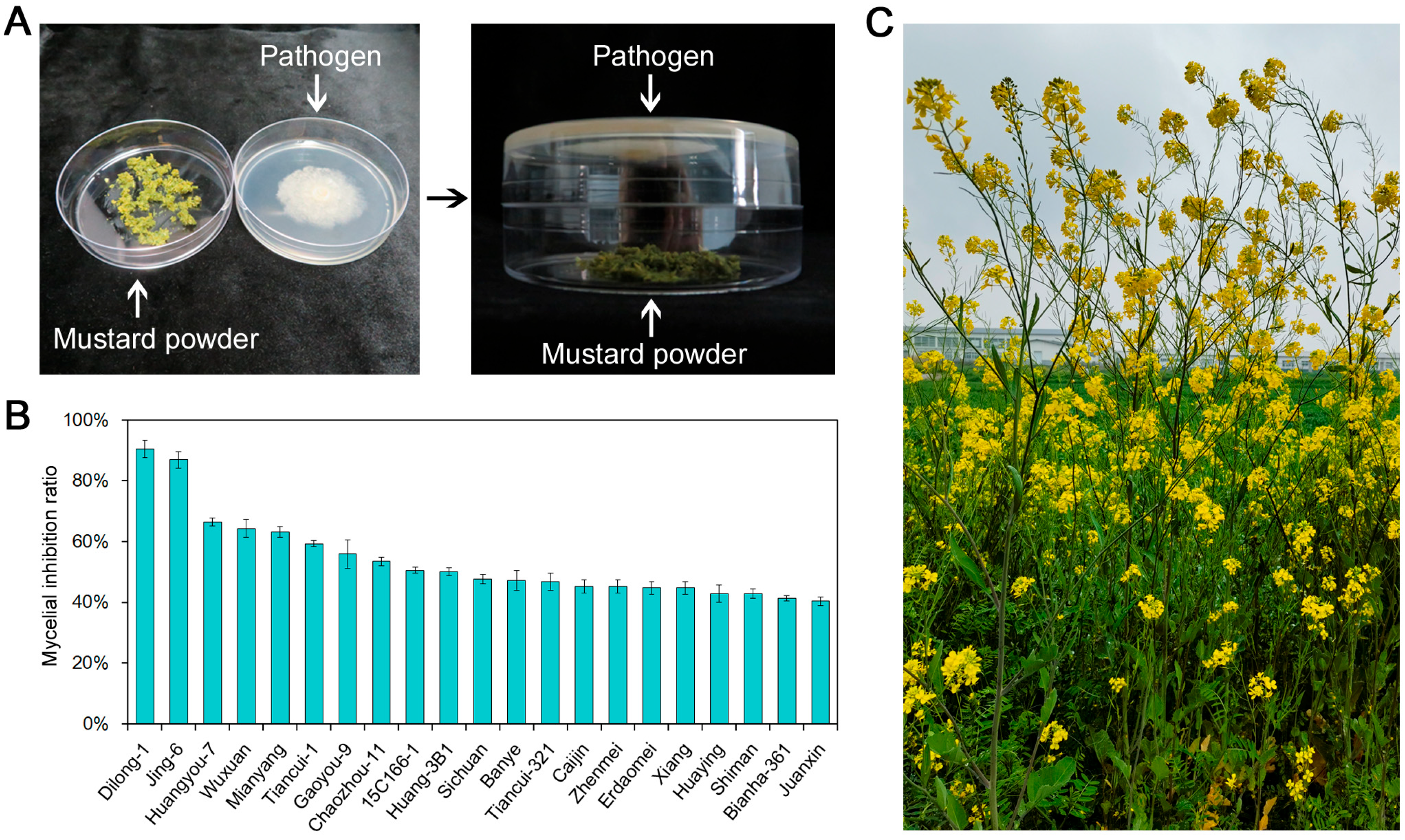
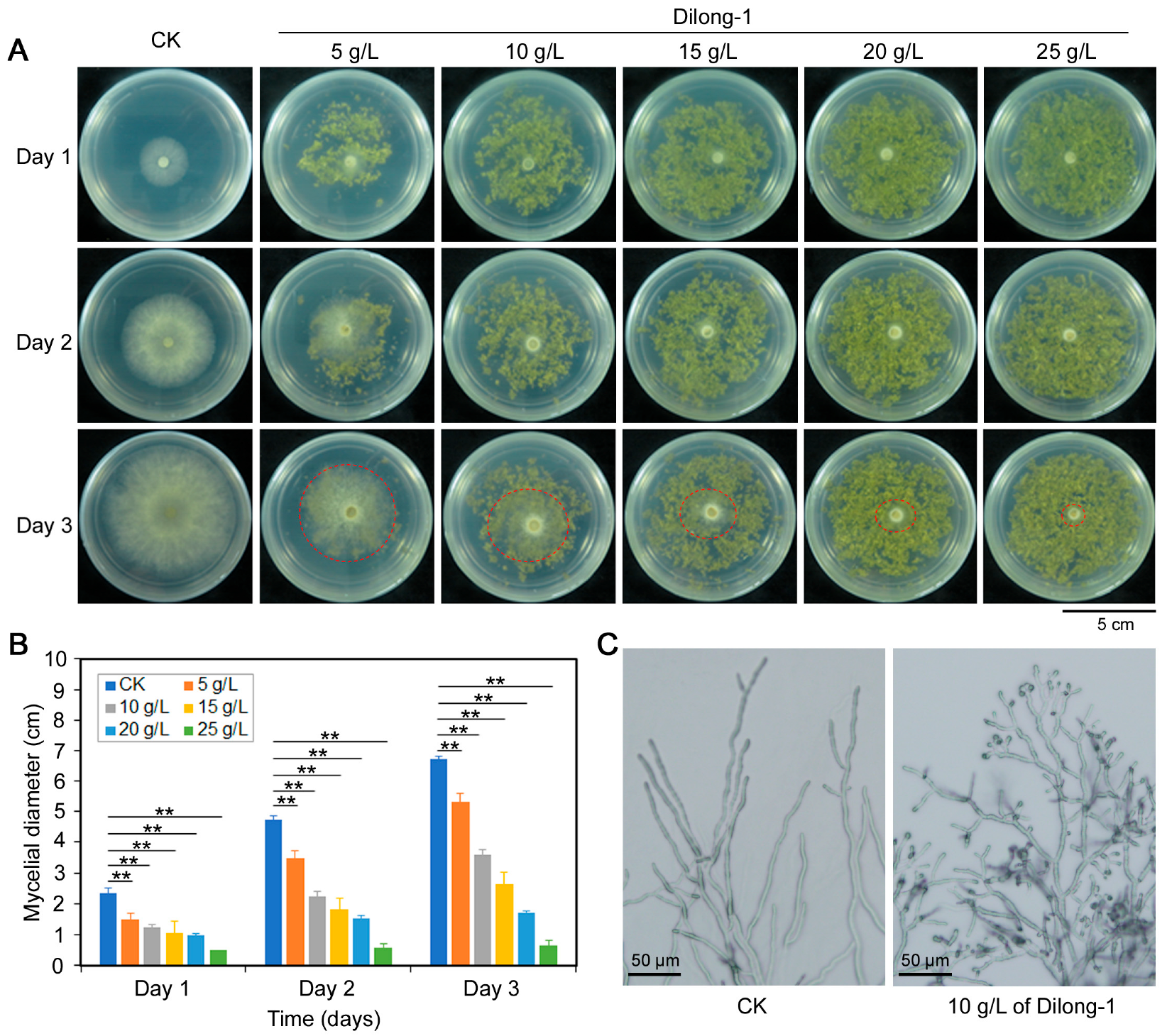
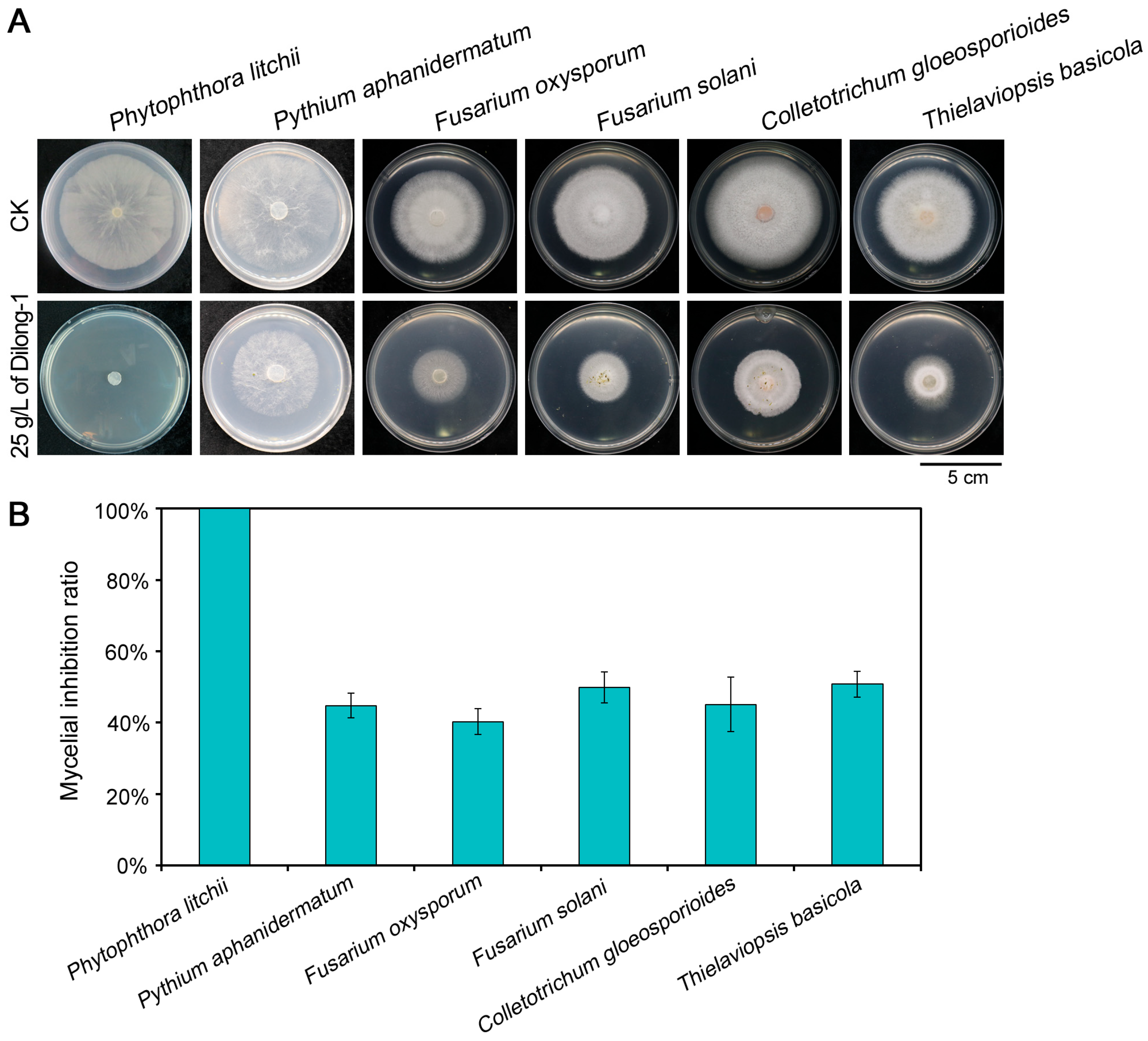
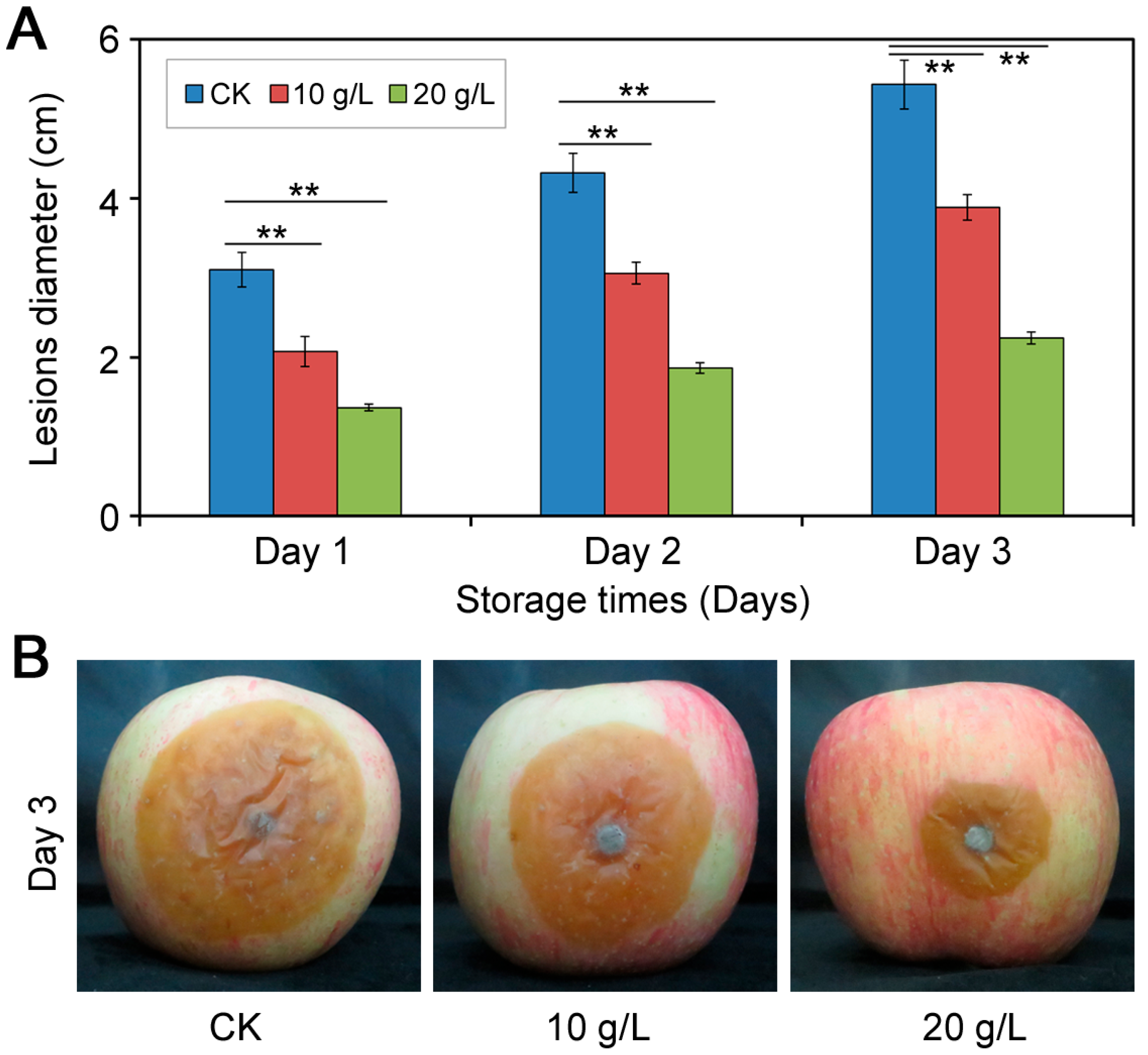
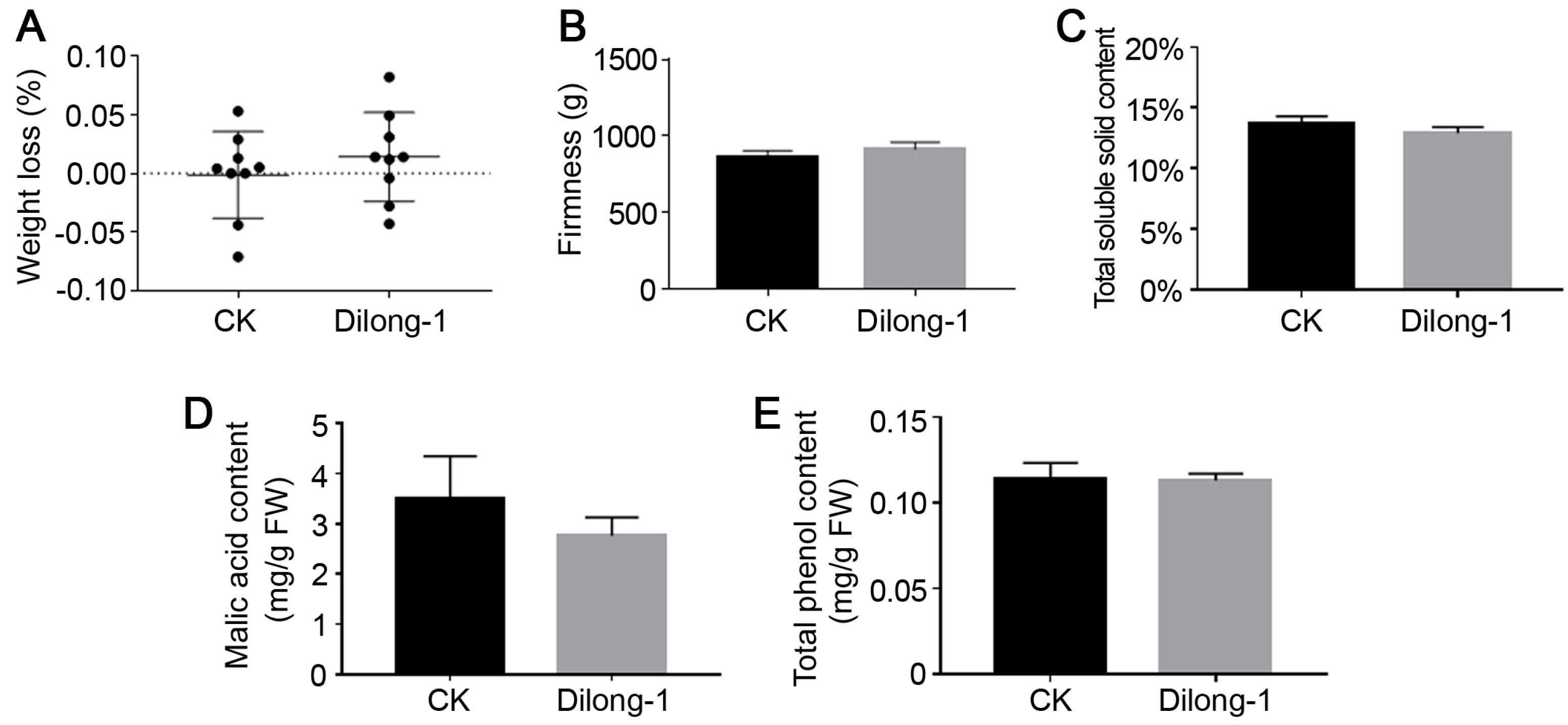
| Sporulation (Spores/mL) | Spore Germination (%) | Length of Germ Tubes (μm) | |
|---|---|---|---|
| CK | 7.0 × 104 a | 91.9 ± 2.1 a | 228 ± 23 a |
| 10 g/L | 2.4 × 103 b | 31.2 ± 1.8 b | 64 ± 14 b |
| 20 g/L | 0 c | NA | NA |
Disclaimer/Publisher’s Note: The statements, opinions and data contained in all publications are solely those of the individual author(s) and contributor(s) and not of MDPI and/or the editor(s). MDPI and/or the editor(s) disclaim responsibility for any injury to people or property resulting from any ideas, methods, instructions or products referred to in the content. |
© 2023 by the authors. Licensee MDPI, Basel, Switzerland. This article is an open access article distributed under the terms and conditions of the Creative Commons Attribution (CC BY) license (https://creativecommons.org/licenses/by/4.0/).
Share and Cite
Tian, Y.; Yang, Z.; Song, W.; Zhao, H.; Ye, Q.; Xu, H.; Hu, B.; Shen, D.; Dou, D. Biofumigation by Mustard Plants as an Application for Controlling Postharvest Gray Mold in Apple Fruits. Agronomy 2023, 13, 1490. https://doi.org/10.3390/agronomy13061490
Tian Y, Yang Z, Song W, Zhao H, Ye Q, Xu H, Hu B, Shen D, Dou D. Biofumigation by Mustard Plants as an Application for Controlling Postharvest Gray Mold in Apple Fruits. Agronomy. 2023; 13(6):1490. https://doi.org/10.3390/agronomy13061490
Chicago/Turabian StyleTian, Yuee, Zitong Yang, Wen Song, Hanqing Zhao, Qin Ye, Heng Xu, Baishi Hu, Danyu Shen, and Daolong Dou. 2023. "Biofumigation by Mustard Plants as an Application for Controlling Postharvest Gray Mold in Apple Fruits" Agronomy 13, no. 6: 1490. https://doi.org/10.3390/agronomy13061490
APA StyleTian, Y., Yang, Z., Song, W., Zhao, H., Ye, Q., Xu, H., Hu, B., Shen, D., & Dou, D. (2023). Biofumigation by Mustard Plants as an Application for Controlling Postharvest Gray Mold in Apple Fruits. Agronomy, 13(6), 1490. https://doi.org/10.3390/agronomy13061490









